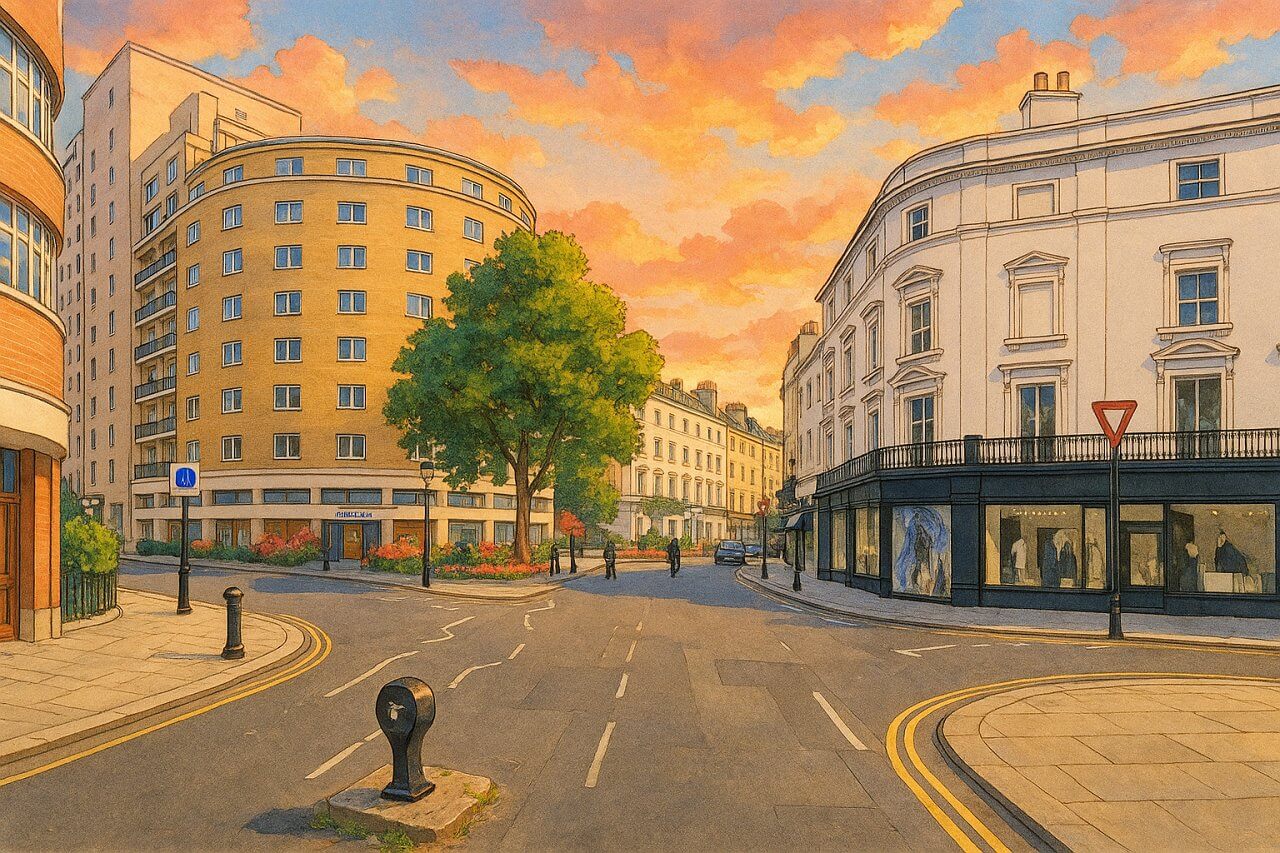
Lowndes Street, London
Lowndes Street is an elegant and historic thoroughfare in the prestigious district of Belgravia, in the City of Westminster. This refined street unfolds in two distinct segments, both residential and commercial in character, meeting at the intersection with West Halkin Street.
Layout and Location
The main section of Lowndes Street runs in a southeast-northwest orientation, beginning at Lowndes Square and continuing until it reaches Chesham Place. A shorter segment extends westward from the intersection with West Halkin Street to join Cadogan Place.
The street serves mostly one-way vehicular traffic. The primary segment operates as a one-way system directing cars from northwest (Lowndes Square) to southeast (Chesham Place), while the minor arm connecting to Cadogan Place is also one-way, facilitating westward movement. Sidewalks line both sides of the road, offering pedestrians a quiet walking route through one of central London’s most exclusive neighbourhoods.
History and Name Origin
Lowndes Street forms part of the grand urban development of Belgravia undertaken during the early to mid-19th century. The area was developed on land once belonging to the Grosvenor Estate, as London expanded westward from its traditional core. Lowndes Street appears in maps and documents from the 1820s and 1830s.
The street takes its name from William Lowndes (1652–1724), a prominent English politician and Secretary to the Treasury, whose descendants once owned land in the area. His family name lives on in several street names nearby, including Lowndes Square and Lowndes Place.
The name is pronounced "Lownz", rhyming with "sounds". Its pronunciation in the International Phonetic Alphabet is /laʊndz/. 
Character and Ambience
Lowndes Street is best described as quietly affluent, with a refined but understated character. The architecture is a blend of mid-Victorian stuccoed terraced houses and high-end post-war and modern residential blocks. Many of the properties are now divided into luxury apartments, while ground floors along certain stretches host boutique shops, galleries, and embassies.
The street’s tone is primarily residential, although a few commercial premises, including luxury interior design stores and private clinics, maintain a discreet presence. A sense of exclusivity permeates the area, yet it lacks the ostentation found in nearby Knightsbridge.
Notable Sights and Nearby Attractions
Though Lowndes Street itself is not packed with tourist attractions, it benefits from close proximity to several notable London landmarks:
- Lowndes Square – A private garden square surrounded by elegant residences, offering picturesque views for residents.
- Belgrave Square – One of London’s grandest squares, just a short walk away, with diplomatic buildings and impressive neoclassical townhouses.
- Sloane Street – High-end shopping destination with international designer boutiques, easily accessed from the west end of Lowndes Street.
- Hyde Park – Just a few minutes’ walk away, offering vast green space for recreation and relaxation.
Property and Real Estate
Lowndes Street falls within one of London’s most expensive and sought-after residential areas. As of early 2025, average asking prices for properties on Lowndes Street range between £2,500 to £3,500 per square foot, depending on the condition and configuration. That equates to approximately £26,900 to £37,700 per square metre.
Typical properties include:
- Two-bedroom flats averaging 1,200 sq ft (c. 111 sq m) priced around £3–4 million.
- Larger duplex or lateral apartments up to 3,000 sq ft (c. 279 sq m) commanding prices well over £10 million.
These prices far exceed London’s average, reflecting the prestige and central location of Belgravia.
Transport Connections
Nearest Tube Stations
- Knightsbridge Station (Piccadilly Line) – approximately 6 minutes on foot to the northwest.
- Sloane Square Station (District and Circle Lines) – around 10 minutes’ walk to the south.
- Hyde Park Corner Station (Piccadilly Line) – about 10 minutes away to the northeast.
Nearby Bus Stops
Several bus routes operate along Sloane Street and Knightsbridge, both of which are within easy walking distance. Key routes include:
- Route 19 – Finsbury Park to Battersea Bridge via Piccadilly and Sloane Street.
- Route 22 – Piccadilly Circus to Putney Common.
- Route C1 – Victoria Station to White City.
All provide convenient access to major areas including the West End, Chelsea, and Victoria.
Fun Fact
Lowndes Street was once home to the Lowndes Hotel, a fashionable retreat in the 20th century before being integrated into the Jumeirah Carlton Tower complex. The street’s discretion and proximity to embassies have made it a favourite address for diplomats and visiting dignitaries over the decades.
Quick Facts
- Location: Belgravia, City of Westminster
- Connects: Lowndes Square (NW), Chesham Place (SE), Cadogan Place (W)
- Pronunciation: “Lownz” (/laʊndz/)
- Named After: William Lowndes (1652–1724)
- Built: Early-to-mid 19th century
- Street Type: Two segments, mostly one-way
- Character: Quiet, elegant, mostly residential
- Nearby Sights: Lowndes Square, Sloane Street, Belgrave Square, Hyde Park
- Property Prices (2025): £2,500–£3,500/sq ft (£26,900–£37,700/sq m)
- Nearest Tube: Knightsbridge, Sloane Square, Hyde Park Corner
- Bus Routes: 19, 22, C1 (via Sloane Street and Knightsbridge)
- Fun Fact: Former site of the Lowndes Hotel, favoured by dignitaries
Map of Lowndes Street, London

Painting of Lowndes Street, London (View image in full size)